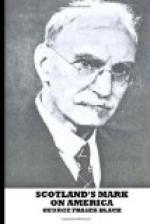Down to the present day the descendants of these Ulster Scots settlers living in the United States who have maintained an interest in their origin, always insist that they are of Scottish and not of Irish origin. On this point it will be sufficient to quote the late Hon. Leonard Allison Morrison, of New Hampshire. Writing twenty-five years ago he said: “I am one of Scotch-Irish blood and my ancestor came with Rev. McGregor of Londonderry, and neither they nor any of their descendants were willing to be called ‘merely Irish.’ I have twice visited,” he adds, “the parish of Aghadowney, Co. Londonderry, from which they came, in Ireland, and all that locality is filled, not with ‘Irish’ but with Scotch-Irish, and this is pure Scotch blood to-day, after more than 200 years.” The mountaineers of Tennessee and Kentucky are largely the descendants of these same Ulster Scots, and their origin is conclusively shown by the phrase used by mothers to their unruly children: “If you don’t behave, Clavers [i.e., Claverhouse] will get you.”
If we must continue to use the hyphen when referring to these early immigrants it is preferable to use the term “Ulster Scot” instead of “Scotch-Irish,” as was pointed out by the late Whitelaw Reid, because it does not confuse the race with the accident of birth, and because the people preferred it themselves. “If these Scottish and Presbyterian colonists,” he says, “must be called Irish because they had been one or two generations in the north of Ireland, then the Pilgrim Fathers, who had been one generation or more in Holland, must by the same reasoning be called Dutch or at the very least English Dutch.”
To understand the reasons for the Scots colonization of Ulster and the replantation in America it is necessary to look back three centuries in British history. On the crushing of the Irish rebellion under Sir Cahir O’Dogherty in 1607 about 500,000 acres of forfeited land in the province of Ulster were at the disposal of the crown. At the suggestion of King James the I. of England, Ulster was divided into lots and offered to colonists from England. Circumstances, however, turned what was mainly intended to be an English enterprise into a Scottish one. Scottish participation “which does not seem to have been originally regarded as important,” became eventually, as Ford points out, the mainstay of the enterprise. “Although from the first there was an understanding between [Sir Arthur] Chichester and the English Privy Council that eventually the plantation would be opened to Scotch settlers, no steps were taken in that direction until the plan had been matured ... The first public announcement of any Scottish connection with the Ulster plantation appears in a letter of March 19, 1609, from Sir Alexander Hay, the Scottish secretary resident at the English Court, to the Scottish Privy Council at Edinburgh.” In this communication Hay announced that the king “out of his unspeikable




